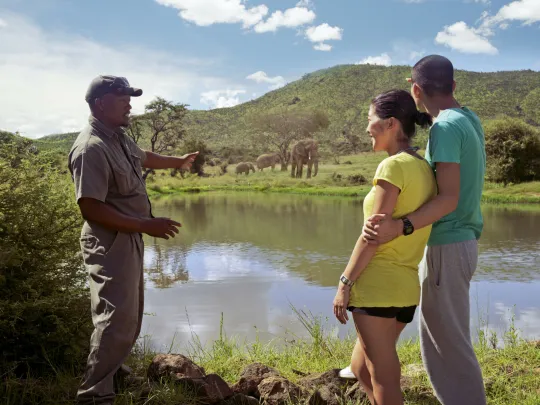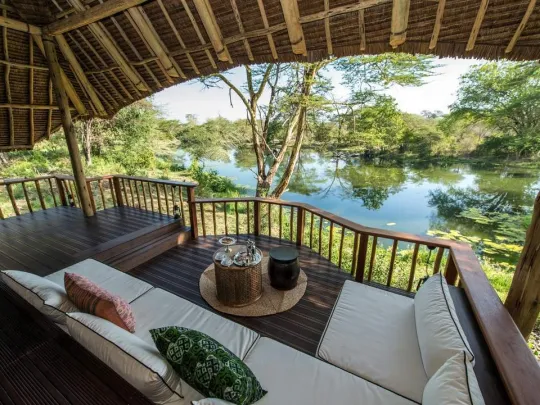12 Wildlife Photography Tips for Your Next Safari (Beginner-Friendly Guide)
A dedicated photographic safari is different from a regular safari. Of course, you'll get great photo opportunities on any safari, but if you're serious about wildlife photography, you'll want to consider a specialist photographic safari.
These are often hosted by professional photographers who coach guests on technique, equipment, and positioning. Even without a photographic host, though, you can have a fantastic safari with careful planning and the right approach. Here are my top tips for getting better wildlife photos on safari.
1. Choose the Right Safari Destination and Season for Photography

The dry season is great for photographing wildlife at waterholes
To get the best opportunities for wildlife photography, you need to choose the right destination and the right season. Some safari areas are known for consistently excellent game viewing. If you're hoping to photograph specific animals, such as wild dogs, cheetahs, leopards, rhinos or elephants, get expert advice on which reserve offers the best chance of seeing them.
Remember that in most national parks, vehicles are not allowed off-road, which can limit positioning for photography. In private concessions or private reserves, guides are often permitted to go off-road, which allows you to get closer and position yourself for the best light.
Generally, the dry season is best for wildlife photography. The bush is more open, animals gather at waterholes, and the dusty air creates warm tones and spectacular sunsets. But don't discount the green season: birders, flower enthusiasts, and photographers who love dramatic skies and lush backdrops may find the rainy season just as rewarding.
2. Bring the Best Camera Gear for Safari (and Protect It)

A zoom or telephoto lens is essential for wildlife photography
Your safari photos will only be as good as the equipment you bring. For wildlife photography, a zoom or telephoto lens is essential. Most photographers rely on a range between 200mm and 500mm. Anything shorter and your subject will often be too far away; anything bigger than 600mm is usually too bulky and prone to camera shake.
If you don't own the gear you want, consider renting professional equipment for your trip. Choose the best-quality lenses you can afford. Fast lenses (with wide maximum apertures) allow in more light and help you shoot at higher shutter speeds.
To avoid blurry images, bring a tripod, monopod, or beanbag. Ask in advance about mounts that can be used on safari vehicles. Protect your gear from dust; Pelican cases or other dust-proof protective cases are a good investment.
3. Know Your Camera Settings Before You Go
It's important to be completely familiar with your camera before heading on safari. Learn your buttons and settings, practice locking focus and exposure, and know how to change lenses or ISO quickly.
On safari, Murphy's Law applies: the best action usually happens while you're fiddling with settings. Don't rent or buy a new camera body just before your trip. If you do upgrade, buy several months in advance and spend time practising. You don't want to spend your safari learning the basics of a new camera.
4. Be Ready to Shoot in an Instant

Always be on standby and ready to shoot
One of the biggest differences I notice between amateur and professional photographers is readiness. Professionals always have their settings dialled in and are ready to shoot. When a cheetah explodes into a chase, the pros are already firing, while many beginners are still fumbling with ISO or lens caps.
Anticipate the action. Constantly check your light conditions and adjust your settings ahead of time, so when the moment arrives, you're ready.
5. Master the Basics: Focus and Sharpness

Focus on the most important part of the subject
Sharpness is fundamental to great photography. To get pin-sharp images, you need to balance three things: focus, aperture, and shutter speed.
Always be mindful of your focus point and auto-focus mode. With portraits, the eyes are usually the most important — but not always. If you're using centre-point focus, know how to lock it while recomposing.
Understand how aperture (f-stop) affects depth of field. At very wide apertures, your subject's eyes may be sharp while the nose or ears are soft. At higher f-stops, you'll have more in focus, but you risk motion blur from slower shutter speeds. Practice balancing these settings before your safari so you can react instinctively.
6. Master the Basics: Composition on Safari

Don't be afraid of negative spaces
Composition can make or break your images. Start with the basics: don't cut off tails, horns, or legs, and avoid zooming in too tight. It's often better to shoot wider and crop later — today's cameras have plenty of resolution.
Look for pleasing balance in the frame. Use natural elements such as trees, rivers, or other animals as leading lines. Leave space for the animal to look into; don't frame it so tightly that it feels cramped against the edge of the shot.
7. Master the Basics: Exposure and Metering

A lion portrait
Correct exposure is critical. Always expose for the most important part of the photo — usually your subject, though not always. Learn how to use spot metering and exposure lock.
On safari, it's often safer to slightly underexpose rather than overexpose, especially in bright conditions. Experiment with bracketing and check your shots often so you can adjust on the spot.
8. Work with the Best Natural Light

Early morning or late afternoon provides the best light
Light can transform a photo. Usually, the best results come when the sun is behind you, but side-lighting and backlighting can also be very effective. Early mornings and late afternoons give you the soft, warm light most photographers love.
This means being out before sunrise — that first golden hour is magic. Midday light is often harsh, with strong contrast, but on overcast days, you can still shoot with great results. If you don't shoot in RAW, make sure your white balance settings are correct. If you've always used auto, try experimenting with manual white balance.
9. Perfect Your Timing and Anticipate Behaviour

Take an image that tells a story
Even the most beautiful animal in perfect light can look static without a story. The most striking wildlife photos often capture behaviour — interaction, action, or emotion.
To do this, timing is everything. Learn animal behaviour, anticipate what might happen, and be ready. Small moments — a flick of an ear, a playful nudge, a head rub — can elevate a photo from ordinary to memorable.
10. Book a Private Vehicle for Photography Flexibility
Sharing a safari vehicle with non-photographers often leads to frustration. Space is limited, people move around while you're shooting, and they may want to leave a sighting before you're ready.
Booking a private vehicle gives you freedom: more space for equipment, control over positioning, and flexibility with timing. It costs extra, but if photography is your main goal, it's worth it.
11. Communicate Clearly with Your Safari Guide
Your guide plays a crucial role in your photographic safari. Don't assume they know your needs as a photographer — communicate clearly. Tell them what shots you want, what direction the light should be from, and how you'd like the vehicle positioned.
Ask them to help anticipate behaviour. For example, guides know when lions are likely to greet each other affectionately, or where a leopard might emerge from a track. Remind them to switch off the vehicle at sightings, and not to restart until you're ready. Guides don't always think like photographers, so guide them too.
12. Don't Run Out of Batteries or Memory Cards
Few things are worse than running out of memory or battery power at the best sighting of your trip. Always bring spare memory cards on every drive, and carry extra batteries. Charge them overnight, and find out about power supply at your lodge. Don't forget the right travel adapter for your charger.
Types of Photographic Safaris You Can Book

If you can, book a private vehicle
In a sense, all our safaris are photographic; we don't do hunting safaris. But serious photographers often prefer a dedicated photographic safari.
One option is to join a scheduled group safari hosted by a professional photographer. These small-group tours (usually 3–6 photographers per vehicle) have set dates and itineraries. A photographic host helps direct the guide and shares tips with guests during drives.
Another option is a private photographic safari, with or without a professional photographer. Having a photographic host adds value but also increases the cost, since their daily fee, flights, and accommodation are included.
Whichever option you choose, I recommend booking a private vehicle whenever possible. Shared drives with non-photographers often result in compromise. At some lodges, especially high-end ones, you may even find custom photographic vehicles or boats — designed with camera mounts and extra space — which can make a huge difference to your experience.
Learn the Basics at a Photographic Hide

The photographic hide at Mashatu
Update: We've added this fresh tip for beginners!
If you're new to wildlife photography, one of the best ways to start is by booking a safari at a lodge that offers a photographic hide with a qualified tutor. A hide allows you to observe animals at close quarters without being noticed, often at eye level, and without the jolts of a moving vehicle. This gives you unique angles and more time to practice composition, light, and timing.
A professional wildlife photographer on hand can guide you through the fundamentals of both camera settings and animal behaviour. Learning how to read animal body language is just as important as mastering aperture and shutter speed — it helps you anticipate the perfect moment to capture the shot.
Photographic hides are also beginner-friendly because you're in a comfortable, stable position with plenty of time to experiment. It's an incredible way to build confidence before venturing out into the bush with your camera.
Ready to experience this for yourself? Chat to us about lodges with world-class photographic hides and we'll match you with the right option for your skill level and interests.
You may also want to look at

A Rare Encounter with Africa's Most Elusive Big Cat
Wild Wings Safaris guide Simon Vegter travelled to Laikipia Wilderness Camp in May 2023, seeking the legendary black leopard, Giza Mrembo—Swahili for "the beautiful darkness." This rare melanistic leopard, moving like a shadow through Kenya's acacia-dotted landscape, has captivated wildlife enthusiasts worldwide.

How to Choose the Best Safari Destination - Part 1
Choosing a good safari destination is key to ensuring a great safari experience. But where do you start? With so many different safari destinations to choose from, how do you choose the right one for your safari? This is part 1 of a 2-part series.

How to Choose the Best Safari Destination - Part 2
In part one of this two-part series, we looked at selecting the best destination or game reserve for your safari. In part two, we will look at how to choose the best lodge or camp for your safari. Grab a coffee and enjoy the read!
About the author

Onne Vegter is the managing director of Wild Wings Safaris. He has a deep love for Africa's people, wildlife and natural heritage. Having travelled extensively to Africa's top safari destinations, his writing is based on his personal travel adventures and decades of experience in the safari industry. Follow him on X at @OnneVegter.









